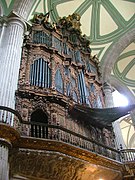
Mexico City Metropolitan Cathedral
The Metropolitan Cathedral of the Assumption of the Most Blessed Virgin Mary into Heaven (Spanish: Catedral Metropolitana de la Asunción de la Bienaventurada Virgen María a los cielos) is the cathedral church of the Roman Catholic Archdiocese of Mexico.[2] It is situated on top of the former Aztec sacred precinct near the Templo Mayor on the northern side of the Plaza de la Constitución (Zócalo) in the historic center of Mexico City. The cathedral was built in sections from 1573 to 1813[3] around the original church that was constructed soon after the Spanish conquest of Tenochtitlan, eventually replacing it entirely. Spanish architect Claudio de Arciniega planned the construction, drawing inspiration from Gothic cathedrals in Spain.[4]
Mexico City Metropolitan Cathedral
Mexico City, Mexico
2 February 1656[1]
1573
1813
128 metres (420 ft)
59 metres (194 ft)
67 metres (220 ft)
Chiluca, stone, tezontle
Due to the long time it took to build it, just under 250 years, virtually all the main architects, painters, sculptors, gilding masters and other plastic artists of the viceroyalty worked at some point in the construction of the enclosure. The long construction time also led to the integration of a number of architectural styles in its design, including the Gothic, Baroque, Churrigueresque, Neoclassical styles, as they came into vogue over the centuries. It furthermore allowed the cathedral to include different ornaments, paintings, sculptures and furniture in its interior.[5][6][3] The project was a point of social cohesion, because it involved so many generations and social classes, including ecclesiastical authorities, government authorities, and different religious orders.[7]
The influence of the Catholic Church on public life has meant that the building was often the scene of historically significant events in New Spain and independent Mexico. These include the coronations of Agustin I and his wife Ana María Huarte in 1822 by the President of the Congress, and Maximilian I and Empress Carlota of Mexico as emperors of Mexico by the Assembly of Mexican notables;[8][9][10][11] the preservation of the funeral remains of the aforementioned first emperor; burial, until 1925, of several of the independence heroes, such as Miguel Hidalgo y Costilla and José María Morelos; the disputes between liberals and conservatives caused by the separation of the church and the state in the Reform; the closure of the building in the days of the Cristero War; and the celebrations of the bicentennial of independence, among others.[12]
The cathedral faces south. It is approximately 59 metres (194 ft) wide by 128 metres (420 ft) long, with a height of 67 metres (220 ft) to the tip of the towers. It consists of two bell towers, a central dome, and three main portals. It has four façades which contain portals flanked with columns and statues. It has five naves consisting of 51 vaults, 74 arches and 40 columns. The two bell towers contain 25 bells. The tabernacle, adjacent to the cathedral, contains the baptistery and serves to register the parishioners. There are five large, ornate altars, a sacristy, a choir, a choir area, a corridor and a capitulary room. Fourteen of the cathedral's sixteen chapels are open to the public. Each chapel is dedicated to a different saint or saints, and each was sponsored by a religious guild. The chapels contain ornate altars, altarpieces, retablos, paintings, furniture and sculptures. The cathedral is home to two of the largest 18th-century organs in the Americas. There is a crypt underneath the cathedral that holds the remains of many former archbishops. The cathedral has approximately 150 windows.[3]
Over the centuries, the cathedral has suffered damage. A fire in 1967 damaged a significant part of the cathedral's interior. The restoration work that followed uncovered a number of important documents and artwork that had previously been hidden. Although a solid foundation was built for the cathedral,[13] the soft clay soil it is built on has been a threat to its structural integrity. Dropping water tables and accelerated sinking caused the structure to be added to the World Monuments Fund list of the 100 Most Endangered Sites. Restoration working beginning in the 1990s stabilized the cathedral and it was removed from the endangered list in 2000.[14]















